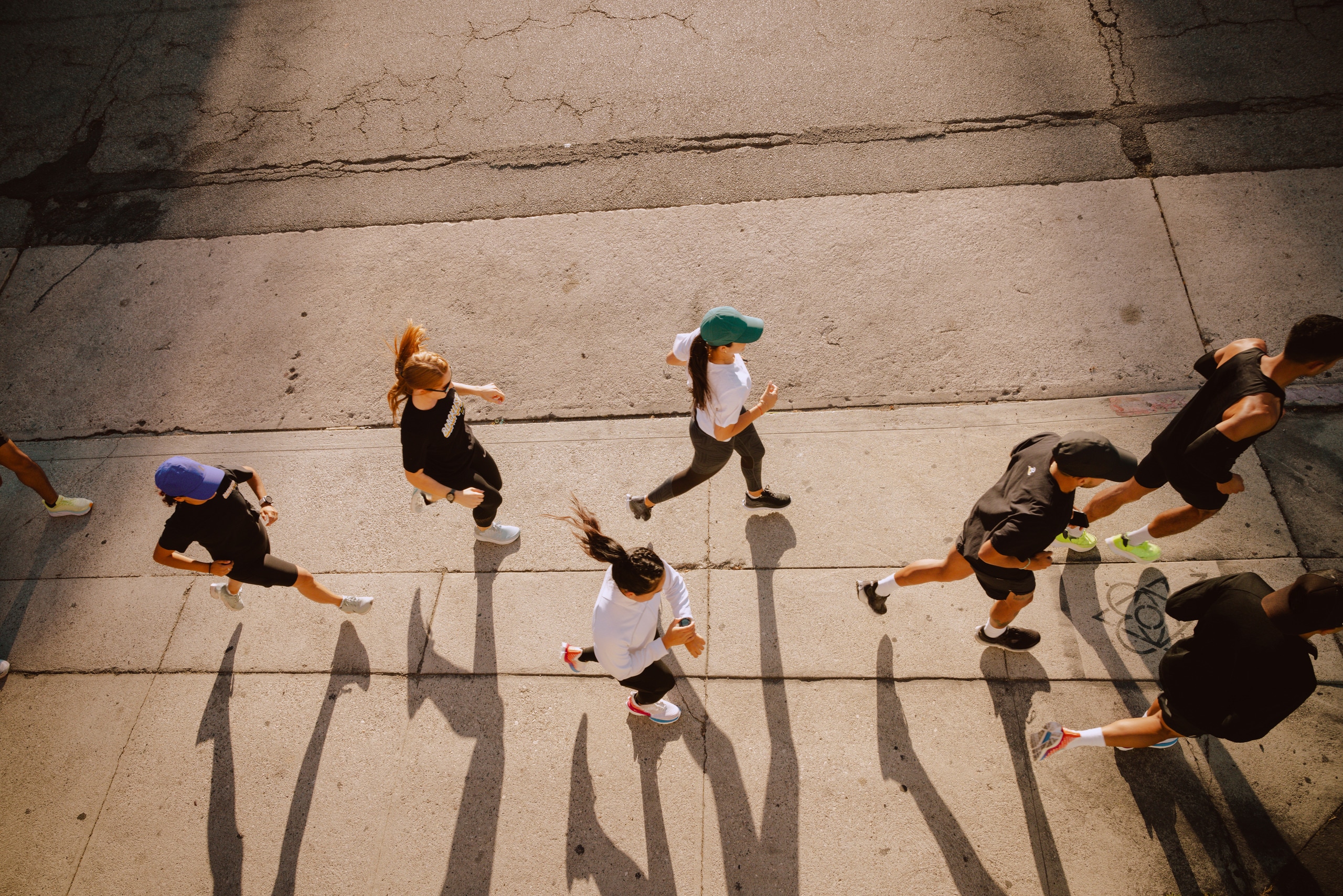Whether you’re running for fun or training with a goal in mind, the right pair of running shoes will cushion, support and protect your feet while providing a solid foundation for your entire body. To help sort through the options and determine the most important aspects of choosing running shoes, we spoke with experts including REI product copyeditor and ultrarunner Yitka Winn, REI store manager and shoe expert Alan Ortega and REI Co-op Member and gear tester Jason Boyle.
To figure out which shoes are right for you, we’ll look at:
- Where you plan to run. Will you be pounding the pavement, or are gravel paths and dirt trails more your speed? What about cross-training or strength training? This article focuses on road-running shoes, so if your running takes you off the paved path, read How to Choose Trail-Running Shoes.
- How the parts of running shoes affect your running experience. Understanding the different features and design elements in a shoe’s upper, midsole and outsole will help you determine which shoes will jibe with your running style. Whether you’re logging daily, conversation-pace miles, doing some speed training or even racing, there’s a shoe to help you meet your goals.
- How much support you need. Understanding your biomechanics will go far in helping you make the right running shoe selection. Considerations like level of support and drop are helpful in choosing between the various shoes on the market.
- Making sure the shoe fits. Fit is the most important aspect of choosing running shoes, so we’ll look at things that affect how shoes fit your feet and ways to dial in the perfect fit.
Where Do You Plan to Run?
This article focuses on road-running shoes, but it’s worth understanding what sets these apart from trail-running and other athletic shoes.
Designed primarily for pavement and concrete as well as the occasional jaunt onto smooth packed dirt, road-running shoes feature:
- Light and flexible uppers for breathability and comfort.
- Supportive midsoles to cushion and stabilize the body through the repetitive impact of running on hard, even surfaces.
- Flatter, smoother outsoles to create a consistent surface for running on smooth paths.
Shop road-running shoes.
Trail-running shoes are designed to handle dirt paths and routes that might include rocks, roots, mud and other obstacles. They feature:
- Thicker, more durable uppers to handle the rigors of the trail and features like toe caps to help prevent stubbed toes.
- Stiffer midsoles along with features like rock plates to provide a solid platform on uneven terrain and help protect your feet from sharp rocks and roots.
- Bigger lugs—the cleats on the outsole—to provide grip on loose and uneven surfaces.
Shop trail-running shoes.
Shoes designed for cross-training—participating in an activity other than running, like cycling or using an elliptical—share many characteristics with road running shoes; they should be supportive, cushioned and comfortable. Many cross trainers will also feature a lower drop, more flexibility in the upper and midsole, and better support for lateral movement.
Shop cross-training shoes.
Strength training shoes usually feature a low drop for better stability when lifting heavy weight and a wider toebox to allow your toes to splay for better balance. Running shoes with a high drop, lots of cushion or narrow toebox are best avoided as they may throw off your balance and make lifting less stable.
How long should running shoes last? Factors like the runner’s weight, the shoe’s construction and even the type of foam in the midsole will affect a shoe’s lifespan, but in general, a pair of running shoes should last between 300 and 500 miles. There’s no magic number, but there are signs to look for when it’s time to think about replacing your shoes. Read our article on When to Replace Your Running Shoes to learn more.
Road-Running Shoe Uppers
A shoe’s upper—the top part of the shoe where the laces are—has two main jobs: to protect your foot and to hold it securely in place. Because it wraps around your foot, the fit and feel of the upper is the first thing you’ll notice when trying on running shoes.
Uppers are usually made of mesh or knit fabric to allow for breathability while shielding your foot. The type and amount of material used as well as the overall structure of the upper vary based on what kind of running experience the shoe is designed for.
Shoes designed to prioritize comfort, stability and durability generally have uppers with more padding and a more rigid structure—especially in the heel counter, the part of the upper that cradles your heel—and they often use thicker material. The tradeoff is additional weight and reduced breathability, which might make shoes less ideal for longer or faster runs.
Shop Best Running Shoes for Beginners
Shoes designed for speed training and racing use thinner, lighter material in their uppers to make it easier to push the pace while improving breathability. However, shoes with gossamer uppers may not be as durable or feel as comfortable on your feet as their plush counterparts.
Shop Best Running Shoes for Racing
Keep in mind that most shoes fall somewhere on the spectrum between these two extremes, so you can choose the right balance for your running style.
Shop Best Road-Running Shoes: Tested
Here are features you might find when looking at running shoe uppers:
- Gusseted tongues. A shoe’s tongue is the piece of fabric that sits underneath the laces to prevent them from creating uncomfortable pressure points on the top of your foot. While some tongues connect to the upper only near your toes, gusseted tongues also connect on the sides to prevent debris from getting into the shoe and to keep the tongue from shifting to one side. The gusset—the fabric that connects the tongue to the upper—may even wrap around the foot and connect at the base of the upper for an even more secure fit, or lockdown.
- Shoes designed for mostly conversation-pace miles—easy enough for you to say several sentences out loud without needing to take a big breath—will often have tongues that connect to the upper only near the toe. Shoes designed for running at faster paces will often feature gusseted tongues both to keep the thinner tongue in place and to provide a better lockdown.
- Waterproof or water-resistant uppers. On cold, wet days having a waterproof running shoe might make the difference between a great run and a slog. Waterproof running shoes use a waterproof/breathable liner in their upper to keep rain and snow out while also letting some sweat out in the form of water vapor.
- Many shoe brands use GORE-TEX® technology like that found in rain jackets, while others use their own version of a waterproof membrane.
- Water-resistant shoes use tightly woven mesh and/or strategically placed rubber to minimize the amount of water that makes it through. Water-resistant uppers will generally be more breathable than fully waterproof shoes.
- Be aware that in addition to keeping water out, waterproof running shoes also keep heat in. This extra insulation may be a boon on cold days but can cause issues when the temperature climbs.
Video: How to Choose Road-Running Shoes
Road-Running Shoe Midsoles
A shoe’s midsole is, as the name implies, the middle part of the shoe. It uses foam and sometimes other materials to cushion, support and protect your feet while absorbing and dissipating impact forces.
The midsole is where a shoe’s feel, or ride, comes from, so in many ways it’s the most important part of running shoes.
One way to understand midsoles is to think in terms of feel vs. float. Some shoes, those with minimal to moderate cushion, are designed to help you feel more connected to the running surface. Others, like those with maximum cushion, aim to help you to “float” through your run without feeling much of the surface beneath you. Here are some things to consider when choosing a road-running shoe midsole:
Running Shoe Cushion
The most visually obvious difference between midsoles is what’s called the stack height, which refers to the thickness of the foam. Running shoe cushioning generally falls into one of three categories:
- Barefoot/Minimal Cushion: These shoes have little to no foam between you and the ground. While are no firm guidelines exist, barefoot shoes usually have up to 8 mm of rubber and no additional foam cushioning while minimalist shoes may have up to around 20 mm of foam in their midsole.
- Though minimalist shoes not for everyone, fans of this approach to running appreciate the connection they feel to the ground. Some also say that these shoes encourage a more natural gait while running. If you’re not used to them, switching to this style of shoe takes time and patience. Learn more about Minimalist/Barefoot Running Basics.
- Moderate Cushion: Shoes with a moderate stack height, up to around 30 mm, aim to strike a balance between float and feel. They offer more support and protection than minimalist shoes but without the extra weight and bulk of maximalist models.
- Maximum Cushion: With at least 34 mm and up to more than 40 mm of foam underfoot, max cushion shoes deserve their name. Proponents of this style like the extra protection and the feeling of float provided by such imposing midsoles.
- The tradeoffs of running on so much foam include dealing with additional weight and bulk and a decrease in stability that comes with being so high off the ground. Some max cushion shoes add stability by making the foam slightly firmer or by wrapping the midsole higher up the sides of the shoe to help cradle the foot. There are also max cushion shoes that feel very light on the foot, especially those designed to pick up the pace, like the New Balance FuelCell Rebel v5.
- It’s important to note that cushion and softness are not necessarily correlated. It’s possible to find a maximum cushion shoe with firm foam or a moderate cushion shoe with pillowy-soft foam.
Running Shoe Foam
While almost all running shoes use foam in their midsoles, not all foams are the same. The science of foam can get complicated—brands can use a variety of compounds and can tweak their formulas to achieve different outcomes—but the upshot is simple: midsoles fall somewhere on the spectrum between firm and soft.
Firmer midsoles are the go-to for runners who want to feel fast because the rigidity means more energy goes into propelling you forward without it getting lost in soft foam. Firmer shoes are also good for folks who want a little extra stability as the midsole is less likely to deform awkwardly when cornering or when landing unevenly.
On the other hand, many people find running on a firm midsole to be less comfortable, especially during daily easy miles when speed is not the goal.
There’s no easy way to search for shoes based on the firmness of the foam, so your best bet is to look for adjectives like “propulsive,” “snappy” or “stable” when browsing online. Footwear specialists at your local REI are another great resource for finding out about midsole firmness.
Softer midsoles are great for maximizing “float.” When comfort during easy efforts is the most important thing, maximizing softness is the way to go.
One tradeoff when it comes to running in soft shoes is that they’re not as efficient as firmer shoes. In soft shoes, more of your energy is lost to the squish. It’s like what happens when running on sand; some of the force of your push-off goes to compressing the sand, or in this case foam, rather than propelling you forward.
Another thing to keep in mind is that shoes with very soft midsoles are generally less stable than those with firmer midsoles.
When searching for shoes with soft midsoles, look for descriptions like “plush,” “soft” and “premium cushioning.”
Responsive midsoles aim to provide the comfort of a soft midsole without sacrificing the efficiency of a firmer platform. They achieve this either by using proprietary foam, adding a plate to the midsole or doing both.
Advancements in foam compounds have allowed shoe manufactures to create more complex foams that both provide a good deal of softness and quickly bounce back to their original shape. Because they often come with a higher price tag, and don’t last as long as foams designed for daily use, these foams are usually reserved for shoes designed for racing or speed training.
Different brands use different names for these “super foams,”—PEBA, PEBAX and DNA GOLD to name a few. You can also look for descriptors like “responsive,” “springy” and “rebound.”
Plated shoes: Another way to increase the responsiveness of a midsole is to add a stiff plastic or carbon fiber plate. These plates act like springs; they flex as you begin each stride, storing energy, and then spring back into shape to release that energy at toe-off. They also have the benefit of helping add rigidity and stability to soft midsoles.
Plastic plates, usually made from nylon, are the less expensive option and are commonly found in speed trainers, while lighter weight, stiffer carbon fiber plates are the go-to for race day shoes.
Road Running Outsoles
The outsole is literally where the rubber meets the road; it’s the strip of rubber, or sometimes rubberized foam, that covers some or all of the bottom of your shoe to grip the road and protect both your feet and the shoe’s midsole.
While most outsoles can handle most situations, it’s worth understanding how key differences make certain outsoles better for some uses than others:
- Coverage and thickness. Rubber is relatively heavy, so shoes designed for speed training and racing will often place thin rubber only in high-wear areas—like the outer heel and under the big toe—while leaving the midsole exposed in other areas, like under the arch. The resulting weight savings feels great at speed, but the tradeoff is often reduced grip and durability.
Shoes meant to handle daily use will place thicker rubber across more of the shoe for increased grip and protection. These shoes are usually heavier, and some people feel that thick outsoles deaden the midsole’s “pop,” but they’ll generally handle more use than shoes with less rubber in their outsole.
- Outsole patterns. To handle varied running surfaces, most road-running shoe outsoles are not completely smooth. Just like car tires, they feature grooves for extra grip, especially in the rain. Shoes designed for speed usually have smoother outsoles while those designed to handle your daily runs will feature more patterned outsoles for better grip in varied conditions.
How Much Support Do You Need?
Running shoes are classified as either “neutral” or “stability” shoes. Which type of support is right for you depends on how your foot rolls when it hits the ground, or its pronation.
Types of Pronation
Basic pronation or neutral pronation: Most people’s feet roll a bit inward on each landing to absorb and dissipate pressure on their joints. This is known as pronation, and it’s a natural way for your body to reduce impact while running. One way to tell if you pronate neutrally is to look at the bottom of the shoes you’ve been walking or running in; if most of the wear is under the ball of your foot and the outer part of your heel, you likely pronate neutrally.
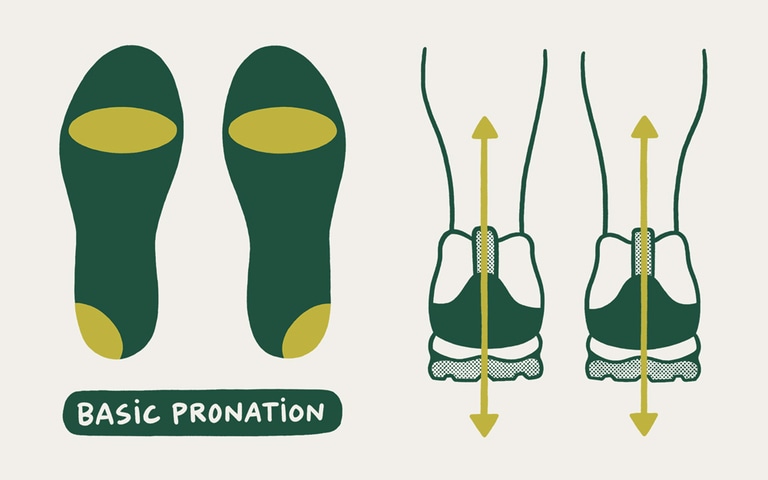
Supination: The opposite of pronation is supination. People who supinate experience an outward roll upon landing. If you supinate, you’ll likely see extra wear along the outside edges of your shoes.

Overpronation: Some people overpronate—their feet roll inward too much—which can put them at risk for injury. Overpronators will often see extra wear along the inside of their shoes, especially near the big toe.
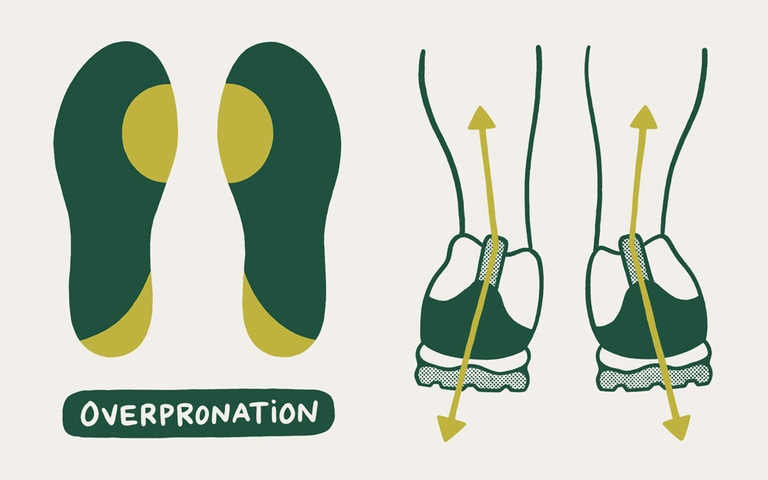
Types of Shoe Support
Stability shoes are a good choice for people experiencing overpronation. They place stiff foam in key areas of the midsole to provide additional support and help counter the excess motion of overpronation.
Neutral shoes are the most common shoes on the market. They are best for people who experience neutral pronation or supination. Neutral shoes don’t feature the type of zonal stiffness found in stability shoes which is designed to counter a specific motion.
Neutral shoes do, however, offer a range of support features. Plastic or carbon plates add stability to neutral shoes by increasing the overall stiffness. Some shoes feature a wider base which can help the shoe feel more stable, while others wrap the midsole up the sides of the shoe to create a stable frame around your foot.
Understanding Drop
Though it may not look obvious, most running shoe midsoles are taller in the heel than in the toes. This difference, measured in millimeters, is known as drop or offset, and it primarily affects how your foot strikes the ground.
Shoes with a high drop , more than 8 mm, will encourage a heel strike (landing first on the heel before rolling through to toe-off), thanks to the extra weight and cushion in the heel.
Shoes with a moderate drop—somewhere between 5 and 8 mm—are versatile options; they work well for everything from heel striking to midfoot and forefoot striking.
Low-drop shoes, anything 4 mm or fewer, are best for midfoot and forefoot strikers.
Shoes with the same amount of cushioning in both the heel and the toes are known as zero-drop shoes. Like low-drop shoes, zero-drop shoes encourage midfoot and forefoot striking. Keep in mind that running in zero-drop shoes will increase the impact on your Achilles tendon, so you’ll need to transition slowly, especially if you’re used to running in high-drop shoes. Read Minimalist/Barefoot Running Basics to learn more about transitioning to zero-drop shoes.
Though different types of foot strikes have gone in and out of style, there is no one ideal way for your foot to hit the ground. Your best bet is run the way that feels most natural to you and to choose a shoe with the amount of drop that won’t get in the way of your normal gait.
Get a Good Shoe Fit
The most important part of choosing running shoes is finding one that fits well out of the box with no break-in period needed. Your best bet is to head to your local REI to try on a few pairs in person. To learn more, read How to Get a Great Fit in Running Shoes.
Here are some things to keep in mind as you shop:
Get both feet measured: Your foot size changes over time, so it's important to get your feet measured when trying on new running shoes.
Be aware of brand fits. Not all shoes are built for all feet. Brands have their own proprietary foot model, or "last." Some may be wider through the midfoot, others may be narrower in the heel and some may be overall higher in volume to accommodate larger feet.
These idiosyncrasies are something that a footwear specialist will know, which is why an in-store fit session is key. Once you find out which brands use a last that’s similar to your foot, you can shop online and have a better chance of getting shoes that fit.
Foot shape vs. your foot’s shape. More brands are making shoes with added room in the toebox to let your toes splay out with each step, something often described as a “foot shaped” fit. Proponents of these wider toeboxes say they offer a more comfortable fit and a more natural way to run.
For those with narrower feet, however, the extra room may cause issues like blisters or hot spots from toes sliding around. They also might feel sloppier than shoes with a narrower fit through the toebox. Again, much of it comes down to personal preference, so try on a variety of styles before choosing one.
Consider your foot’s width. Some brands make their shoes in both “regular” and “wide” versions. If you feel like you have to squeeze into standard running shoes, it’s worth looking into wide options .
Try on both shoes: Some people have one foot that is larger. Try on both the right and the left shoe and find the pair that fits your larger foot.
Try on shoes at the end of the day: Your feet swell throughout the day and will be largest at the end of the day. This tactic helps you avoid buying shoes that are too small.
Aim for a thumbnail's length of space in the toebox: You should be able to wiggle your toes. The width should be snug but allow a bit of room for your foot to move without rubbing. Laces should be snug but not tight.
Bring along insoles, running socks or orthotics (if you use them): They affect the way your shoe fits.
Lace your shoes correctly: Certain lacing techniques can improve the fit of your shoes. The runner's loop, for example, can help lock your heel in place. Window lacing (box lacing) can help relieve pressure points on the top of your foot. Read How to Lace Running Shoes.
Video: How to Size and Fit Running Shoes
Running Shoe Size Charts
Measure the length and width of your feet using the tips in the video above, then consult with these size charts to find your perfect fit.
Women's Running Shoe Length Size Chart
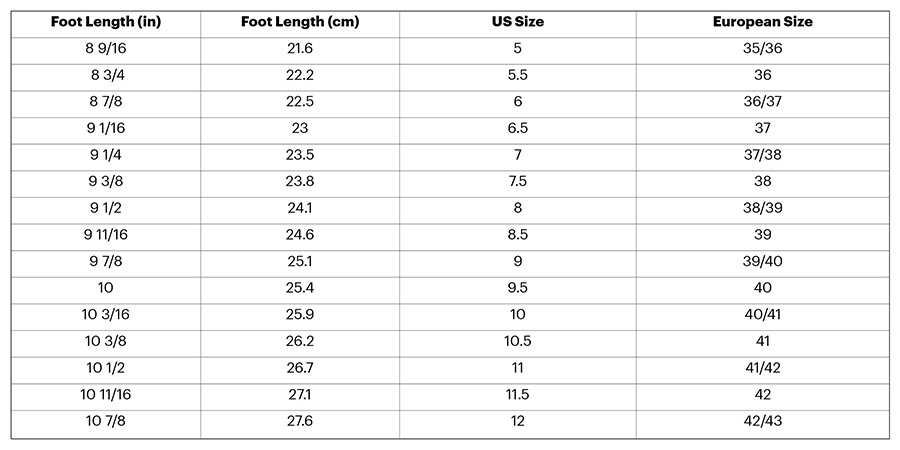
Men's Running Shoe Length Size Chart

Women's Running Shoe Width Size Chart
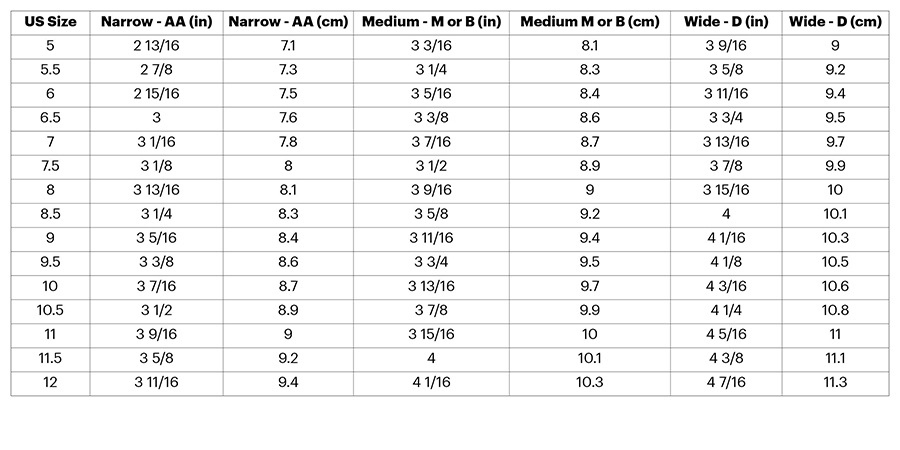
Men's Running Shoe Width Size Chart

Our Experts
Yitka Winn, an REI product copy editor based in Washington, has dozens of trail ultra races under her belt. Highlights include winning Cascade Crest 100 Miler four times and a fifth place finish at Hardrock 100 Endurance Run as well as racing the iconic UTMB (Ultra Trail du Mont Blanc). She’s also the author of Beer Hiking Colorado. When she’s not running or writing, Yitka is likely spending time with her family—hiking, swimming or immersed in a good book.
Jason Boyle, an REI Co-op Member and gear tester based in New Mexico, is a long-time adventure guide with a passion for helping people get outdoors. He has run 55 marathons in 37 states, and is constantly training for the next race—usually while wear-testing a new pair of shoes for Expert Advice.
Alan Ortega, an REI store manager based in California, has been running since he joined the co-op 11 years ago. He’s more often found seeking majestic viewpoints in the mountains than pounding the pavement, though he has completed two road marathons in addition to running the Wonderland Trail at Mount Rainier and the Rim-to-Rim at the Grand Canyon. Alan evaluates running vests by how many applesauce pouches he can fit in the front pockets and shares his apartment with 50 pairs of running shoes.
Braden Van Dragt, a longtime REI contributor based in Washington, has been trail running since he discovered it’s the quickest way to his post-hike burger. He enjoys both ultra and sub-ultra race distances, and since becoming a father he has discovered the joyful pain of road running. His best and worst decision was to race the Boston Marathon followed 3 weeks later by the Miwok 100K. Braden owns the right piece of outdoor gear for any given situation, but he always leaves it at home.
